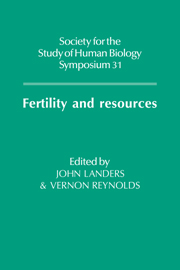Book contents
- Frontmatter
- Contents
- List of contributors
- 1 Introduction
- 2 Environmental and social determinants of fecundity in primates
- 3 Biological aspects of fertility among Third World populations
- 4 A preliminary report on fertility and socio-economic changes in two Papua New Guinea communities
- 5 The cultural context of fertility transition in immigrant Mennonites
- 6 Inter-relationships between consanguinity, religion and fertility in Karnataka, South India
- 7 Resources and the fertility transition in the countryside of England and Wales
- 8 Fertility decline and birth spacing among London Quakers
- 9 Population growth, innovation and resource exploitation
- 10 Fertility decline in developing countries: the roles of economic modernization, culture and Government interventions
- 11 Understanding recent fertility trends in the Third World
- 12 Monogamy, landed property and demographic regimes in pre-industrial Europe: regional contrasts and temporal stabilities
- Index
6 - Inter-relationships between consanguinity, religion and fertility in Karnataka, South India
Published online by Cambridge University Press: 13 March 2010
- Frontmatter
- Contents
- List of contributors
- 1 Introduction
- 2 Environmental and social determinants of fecundity in primates
- 3 Biological aspects of fertility among Third World populations
- 4 A preliminary report on fertility and socio-economic changes in two Papua New Guinea communities
- 5 The cultural context of fertility transition in immigrant Mennonites
- 6 Inter-relationships between consanguinity, religion and fertility in Karnataka, South India
- 7 Resources and the fertility transition in the countryside of England and Wales
- 8 Fertility decline and birth spacing among London Quakers
- 9 Population growth, innovation and resource exploitation
- 10 Fertility decline in developing countries: the roles of economic modernization, culture and Government interventions
- 11 Understanding recent fertility trends in the Third World
- 12 Monogamy, landed property and demographic regimes in pre-industrial Europe: regional contrasts and temporal stabilities
- Index
Summary
Introduction
When considering factors which act as major influences on fertility, religion and consanguinity may feature prominently, especially among the populations of less developed nations. Unfortunately, in many such studies it has been the practice either to assess the effects of religion and consanguinity separately, or to ignore consanguinity altogether. For the investigation of possible inter-relationships between the three parameters South India provides an excellent study centre. In the four southern states, Andhra Pradesh, Karnataka, Kerala and Tamil Nadu, with a combined population in the 1981 Census of India of 164.1 millions, consanguineous marriages are strongly favoured and three major religions, Hinduism, Islam and Christianity, are practised. Therefore detailed studies into the relative roles and effects of religion and consanguinity on fertility are possible at local, state and regional levels.
The study population
Data have been collected on fertility and a variety of fertility-associated parameters in the cities of Bangalore and Mysore, the present and former capital of the state of Karnataka, as part of a prospective neonatal screening programme for the detection of inherited amino acid disorders (Appaji Rao et al, 1988). Within three to five days of the birth of a child, details are obtained by interview from the mother on her age, the degree of genetic relatedness between husband and wife, their religion(s), and the number of liveborn and living children in the family. The consanguinity classes noted are: nonconsanguineous (with a coefficient of inbreeding in the offspring F=O), beyond second cousin (F < 0.0156), second cousin (F= 0.0156), first cousin (F= 0.0625) and uncle–niece (F=0.125).
- Type
- Chapter
- Information
- Fertility and Resources , pp. 62 - 75Publisher: Cambridge University PressPrint publication year: 1990
- 1
- Cited by



